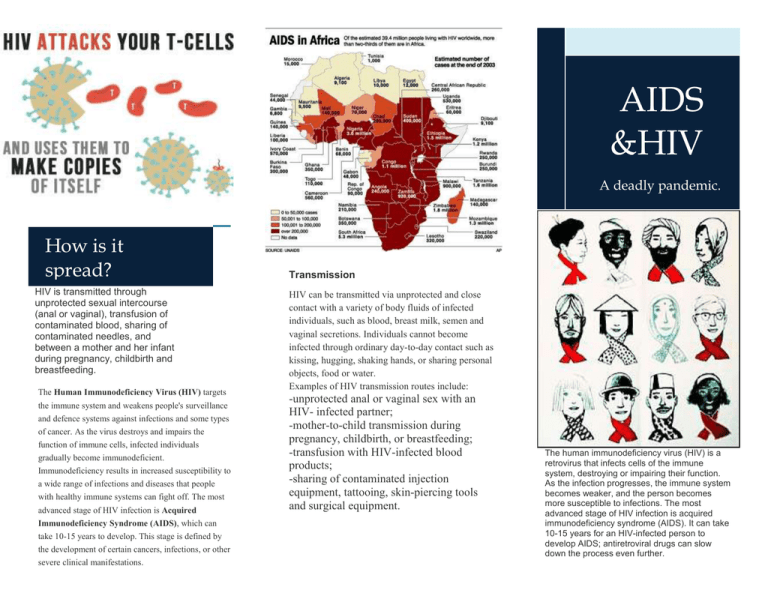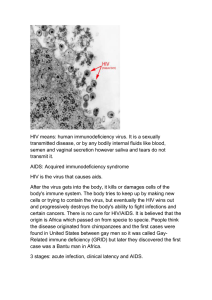In 1981, the first cases of AIDS (Acquired Immune Deficiency
advertisement

Praesent congue sapien sit amet justo. How is it spread? the immune system and weakens people's surveillance and defence systems against infections and some types of cancer. As the virus destroys and impairs the function of immune cells, infected individuals gradually become immunodeficient. Immunodeficiency results in increased susceptibility to a wide range of infections and diseases that people with healthy immune systems can fight off. The most advanced stage of HIV infection is Acquired Immunodeficiency Syndrome (AIDS), which can take 10-15 years to develop. This stage is defined by the development of certain cancers, infections, or other severe clinical manifestations. A deadly pandemic. Transmission HIV is transmitted through unprotected sexual intercourse (anal or vaginal), transfusion of contaminated blood, sharing of contaminated needles, and between a mother and her infant during pregnancy, childbirth and breastfeeding. The Human Immunodeficiency Virus (HIV) targets AIDS &HIV HIV can be transmitted via unprotected and close contact with a variety of body fluids of infected individuals, such as blood, breast milk, semen and vaginal secretions. Individuals cannot become infected through ordinary day-to-day contact such as kissing, hugging, shaking hands, or sharing personal objects, food or water. Examples of HIV transmission routes include: -unprotected anal or vaginal sex with an HIV- infected partner; -mother-to-child transmission during pregnancy, childbirth, or breastfeeding; -transfusion with HIV-infected blood products; -sharing of contaminated injection equipment, tattooing, skin-piercing tools and surgical equipment. The human immunodeficiency virus (HIV) is a retrovirus that infects cells of the immune system, destroying or impairing their function. As the infection progresses, the immune system becomes weaker, and the person becomes more susceptible to infections. The most advanced stage of HIV infection is acquired immunodeficiency syndrome (AIDS). It can take 10-15 years for an HIV-infected person to develop AIDS; antiretroviral drugs can slow down the process even further. Suspendisse potenti. “Duis at neque eu ligula vehicula feugiat.” People living with HIV today. Numbers are growing as medicines to delay onset of AIDS are improving. Treatment HIV can be suppressed by combination antiretroviral therapy (ART) consisting of three or more antiretroviral (ARV) drugs. ART does not cure HIV infection but controls viral replication within a person's body and allows an individual's immune system to strengthen and regain the power to fight off infections. With ART, people living with HIV can live healthy and productive lives. History of AIDS/HIV In 1981, the first cases of AIDS (Acquired Immune Deficiency Syndrome) were identified among gay men in the United States, acquiring the designation, GRID (Gay-Related Immune Deficiency); however, scientists later found evidence that the disease existed in the world for some years prior, i.e., subsequent analysis of a blood sample of a Bantu man, who died of an unidentified illness in the Belgian Congo in 1959, made him the first confirmed case of an HIV infection.





